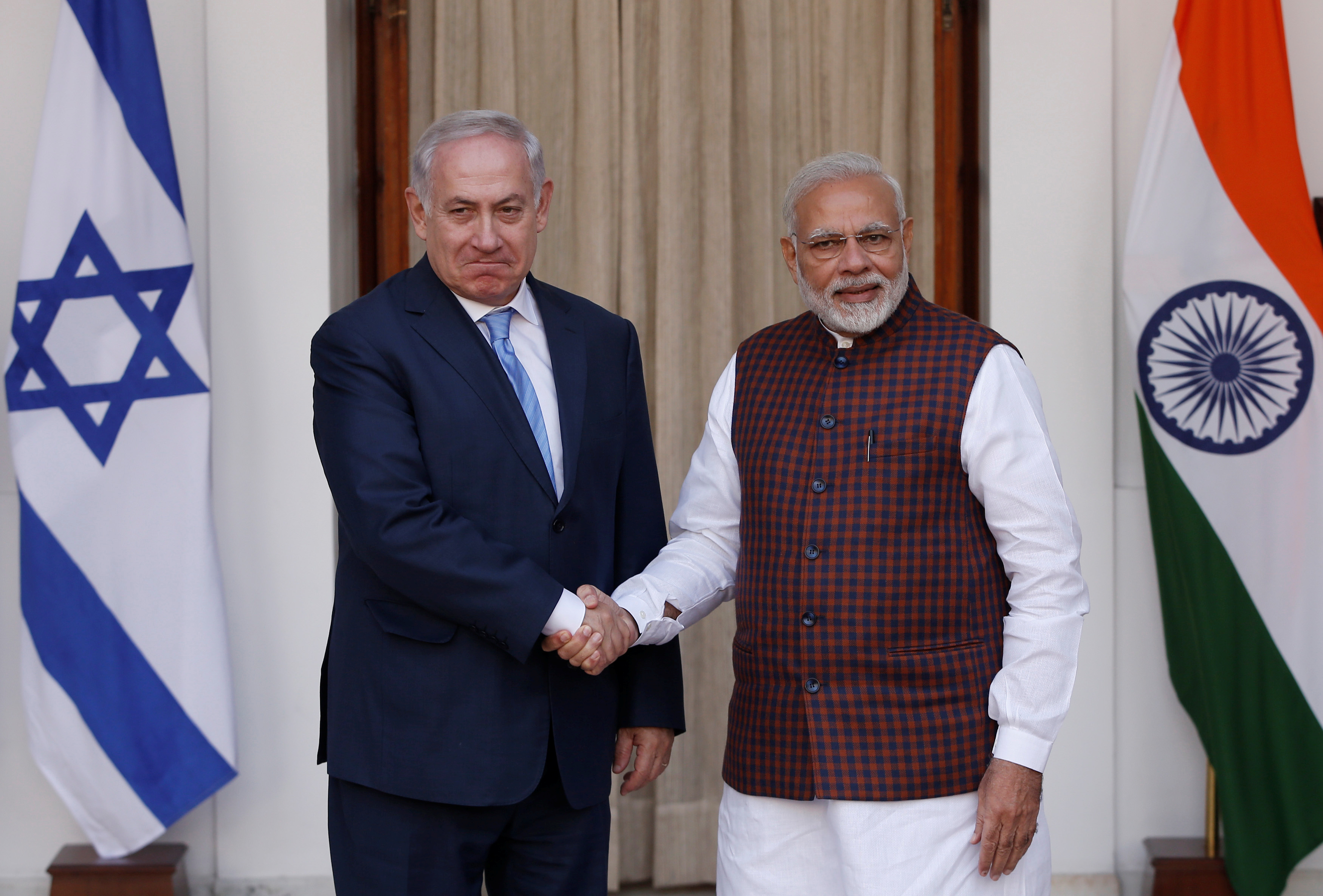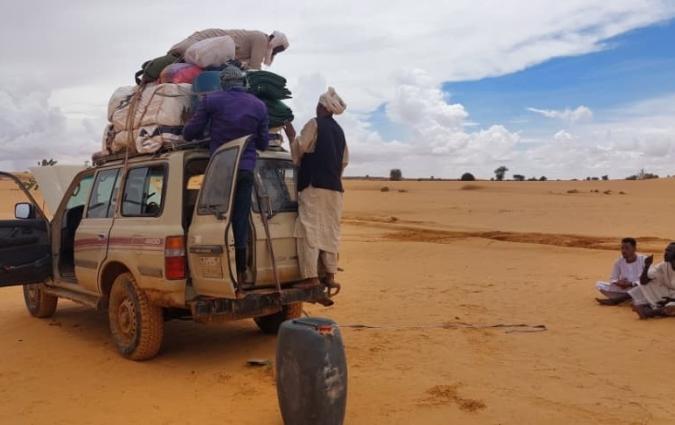A media trip funded by Israel sparks debate in India over biased coverage

Israeli Prime Minister Benjamin Netanyahu shakes hands with his Indian counterpart Narendra Modi during a photo opportunity ahead of their meeting at Hyderabad House in New Delhi, India, January 15, 2018. REUTERS/Adnan Abidi
Editor's note: This piece was written previous to the ceasefire agreement and the exchange of hostages and prisoners which took place on 13 October 2025.
In the evening of 7 August, Assistant Editor of WION News, Sidhant Sibal, posted a photo on X which looked like a child’s doodle. The picture was an autograph of Israeli Prime Minister, Benjamin Netanyahu. Sibal, along with about a dozen other journalists, was in Israel on a trip organised and funded by the Israeli government.
Around the same time, Abhishek Kapoor, senior executive editor with Republic World, started filing a series of videos from Israel where he praised the Israeli Prime Minister’s actions while also failing to provide sufficient context of the violence in Gaza or the history between India and Israel.
“Netanyahu said the future is ‘up, up and up’,” Kapoor said in one of the videos. “That was my takeaway. I would put that as a headline perhaps.” He goes on to call Netanyahu’s actions in Gaza “an act of political courage”.
Gurbir Singh, a senior editor and member of the collective Indian Journalists for Palestine, said that the problem is not only that Indian journalists accepted an all-expenses-paid trip to Israel. The problem, he stressed, is that “they crawled when asked to bend,” referring to a coverage that did not ask tough questions of the Israeli government’s actions in Gaza or even severe press restrictions in the region.
Israel and journalists killings
On 10 August, and as the Indian journalists in Israel were publishing reports on the India-Middle East-Europe Economic Corridor (IMEC), the extension of the Abraham Accords and the protests demanding release of Israeli hostages in Hamas custody, Israel attacked a tent used by journalists near al-Shifa hospital in Gaza City, killing six journalists. Al Jazeera correspondent Anas al-Sharif was one of the six who died on that day. On August 26, another five journalists were killed at Khan Yunis’ Nasser Hospital.
Some of the journalists from India who were on this trip include Zakka Jacob (CNN-News18), Manash Pratim (PTI), Vishnu Som (NDTV), Aditya Raj Kaul (TV9), Abhishek Kapoor (Republic TV), Shubhajit Roy (Indian Express) and Siddhant Sibal (WION). All of them have been asked to comment on their trip and this piece will be updated if they do.
Since October 2023, research from the Committee to Protect Journalists shows that Israel has killed 193 journalists and media workers in Gaza. Over the same period, 31 have been killed in Yemen, six in Lebanon and three in Iran.
Israel has blocked international journalists from entering Gaza and global media outlets have relied on local journalists in the Strip to provide reporting and footage from the area.
AFP, AP, BBC News and Reuters released a joint statement in July warning about the famine's impact on their own journalists on the ground: “For many months, these independent journalists have been the world’s eyes and ears on the ground in Gaza. They are now facing the same dire circumstances as those they are covering.”
In September, the BBC and three international news agencies released a short film calling on Israel to allow foreign journalists into Gaza. The ceasefire agreement didn't include any clauses allowing journalists in Gaza. But Israel's Supreme Court has scheduled a new hearing on this issue for 23 October after a request filed the Foreign Press Association which the court has dismissed several times in the last two years.
Inside the government-funded coverage
With newsrooms' finances under pressure and less money allocated for travel, Indian journalists have been going on fully-funded trips to cover stories for a few decades now.
“A junket is when you are invited by an airline or holiday resort or a sports event or even an art gallery to give them ‘coverage’ in exchange for a fully-funded trip. There is an expected quid pro quo,” said Vaishna Roy, editor of Frontline Magazine, a fortnightly from The Hindu group. “However, a trip sponsored by a government (national or international) or the army is called embedded journalism, and there is little leeway to express independent opinions [in such situations].”
Roy, who has been an editor for decades now, said that many times there is an undertaking that only the “official line” will be conveyed, when governments sponsor trips. “Reporters go into it with eyes wide open. Some get overenthusiastic and pitch things even beyond what they are called upon to do,” she said.
Many observers said that Indian journalists in Israel did exactly that. “Having gone on a junket like that is all right. But to post photographs with Netanyahu and then get his autograph is pretty crazy,” said Ruben Banerjee, former editor-in-chief of Outlook magazine and the author of the book Editor Missing: The Media in Today's India.
Newslaundry, a platform that analyses Indian media, looked at the coverage of Indian journalists on the trip and concluded that most stories were based on interviews with Israeli officials or pro government voices. “Among the common interviewees were Mazal Tazazo, a survivor of the Nova music festival attack; Jonathan Zadka, Head of the Middle East Division at Israel’s Ministry of Foreign Affairs; Daniel Shek, Head of Diplomacy at the Hostages and Missing Families Forum; Ronnie Kaplan, former spokesperson of Israeli Defense Force (IDF),” the story reads.
Vishnu Som, Executive Editor and Principal Anchor of NDTV, anchored two episodes of his show Left, Right & Centre from Israel. He did raise the question of the humanitarian crisis in Gaza. But he gave a lot of airtime to the hostage crisis and the losses faced by Israelis.
Television news relies heavily on visuals and generates emotions based on what can be shown. While broadcasting from Majdal Al Shams, a community in Golan Heights which was captured by Israel from Syria in the 1967 war, Som spoke to a grieving mother who lost her daughter in a missile strike launched from Lebanon.
“It is clear where the sympathies of the viewer lies,” said Banerjee. “It is not enough if you merely mention the humanitarian crises in Gaza and show a grieving mother in her home. Both things do not balance each other out.”
On their trip, the journalists were taken to several kibbutz communities and to the site of the Nova music festival that Hamas attacked on 7 October 2023. So visuals from these places were captured, but very few journalists mentioned the restrictions which kept them from capturing similar images across the border.
Zakka Jacob, Managing Editor of CNN-News18, did. On his X account, he posted: “On the other side of the brown/gray wall is Gaza. Arguably the worst place on the planet right now. Untold death and destruction. We are not allowed to go in and report. But hopefully this war will end, sooner than later.”
Roy said reporters could have contacted people in the West Bank or Gaza [even after they returned]: “Or even talk to voices within Israel that are critical of the government’s actions in Gaza. We all know of the excellent work Haaretz has been doing consistently. There are resistance groups in Israel, there are war veterans, former Zionists – they could all have provided balance.”
India-Israel relations
There are two reasons journalists would be accepting an invitation for an all expenses paid trip to Israel, said the people I interviewed for this piece: the changing nature of India’s relationship to Israel and the changing nature of India’s mainstream media to its leaders.
As soon as India gained independence from Britain in 1947, it voted against the partition of Palestine at the United Nations General Assembly. While India recognised Israel in 1950, no diplomatic relations were established until 1992. Referring to India’s first prime Minister, Jawaharlal Nehru, Singh from Indian Journalists for Palestine said that as one of the leaders of the non-aligned movement, “Nehru was aggressively anti-colonial and was definitely opposed to Israel's occupation of Palestine.”
This viewpoint dominated the media as long as Nehru remained in power and subsequently as his daughter, Indira Gandhi, became India’s Prime Minister. In 1974, India became the first Non-Arab State to recognise the Palestine Liberation Organisation (PLO) as the sole and legitimate representative of the Palestinian people. As a result, India improved its relations with the Arab nations, but also ensured that those nations did not offer unconditional support to Pakistan, India’s regional rival.
In 1988, India became one of the first countries to recognise the Palestinian State. But things have changed dramatically in the last two decades, with India and Israel strengthening their business and military links. "Deepening economic ties with India is one of the goals I have set," Israeli Finance Minister Bezalel Smotrich told Reuters in September while calling India a “true friend of Israel.”
Today, India is one of the largest buyers of Israeli arms. By purchasing more than $2 billion worth of armaments, the Indian market makes up for over 30% of Israeli arms exports.
Merely a few hours after Hamas attacked Israel in October 2023, India’s Prime Minister Narendra Modi was one of the first world leaders to vehemently denounce the “terrorist attacks.”
After Modi became prime minister in 2014, foreign policy was increasingly seen in binary terms, said Banerjee: “We now see everything in terms of Hindus and Muslims. People of Gaza are looked at primarily as Muslims, so the humanitarian catastrophe happening there gets muted responses from the government and the media.”
Where are the editors?
Mainstream media has always toed the government line when it came to issues of foreign policy, said Gurbir Singh, who thinks there is "newfound enthusiasm among the current lot" to please those in power.
It's editors who decide which paid trip to send the reporter on. So Singh blames editors for sending their reporters to Israel knowing that the coverage will be tilted towards the current Israeli government. “Most mainstream editors are now paid to compromise,” said Banerjee. “That is the first prerequisite for remaining an editor [in today's India].”
Indian journalists are not the only ones that have been invited to these trips. In fact, Israel has paid for journalists to visit the country time and again after the 2023 attacks. Senior journalists from major newspapers in Europe and the United States such as The Mirror, The Telegraph, Newsweek, and many others have joined all-expenses-paid trips in 2024 as well.
The Jerusalem Press Club invited journalists on a fully-paid trip to “experience Israel” for four days with visits to some of the areas attacked by Hamas and by Iran in the most recent conflict, as well as meetings with military, business and political leaders.
There have been examples of Indian journalists going on paid trips to foreign countries who have returned to file reasonably balanced stories, said the Frontline editor, Vaishna Roy.
In the late 1980s, the Indian army was involved in operations in a war-torn Sri Lanka. “They regularly carried many Indian journalists from Delhi, Mumbai and Chennai to Jaffna to brief them on the IPKF’s [Indian Peace Keeping Force] operations there and give them a ringside view of the proceedings,” she said.
Many journalists from the Tamil press largely ignored official versions and even countered them on occasion, Roy said: “They filed believable reports despite going on those funded trips.”
In late August many journalists gathered in Mumbai to mourn the death of journalists in Gaza and to condemn their targeting. “We do organise these events to raise awareness among Indian journalists about the situation in Gaza,” said Singh, who acklowledged that many still think that they should concentrate on issues closer home.
In every email we send you'll find original reporting, evidence-based insights, online seminars and readings curated from 100s of sources - all in 5 minutes.
- Twice a week
- More than 20,000 people receive it
- Unsubscribe any time
signup block
In every email we send you'll find original reporting, evidence-based insights, online seminars and readings curated from 100s of sources - all in 5 minutes.
- Twice a week
- More than 20,000 people receive it
- Unsubscribe any time






